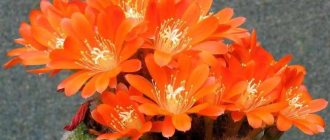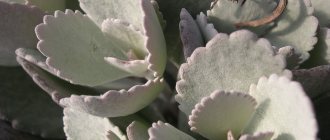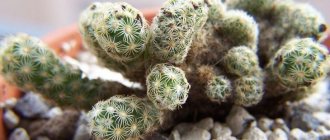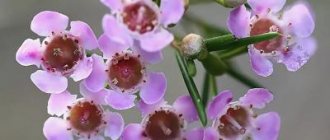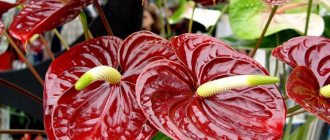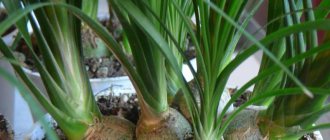Mammillaria is a large genus in the cactus family. Its representatives grow in the form of spherical or cylindrical succulents covered with spines or hairs. Daughter plants or flowers may form in the axils of the papillae
A wide variety of species allows you to choose a cactus to suit every taste.
Description and features of the cactus genus Mammillaria
Cacti of the genus Mammillaria are numerous representatives of the Cactaceae family. Translated from Latin, the name is interpreted as “tubercle”. The appearance is also attractive precisely due to the original structure of the cactus - the presence of original tubercles or papillae.
The natural habitat of the crop is considered to be the territory of Mexico, as well as Colombia, the USA, and Guatemala. It looks great next to the sea coast. The bushes are quite drought-resistant and are ready to withstand long periods when moisture does not enter the soil.
Cactus Mammillaria in natural conditions of existence
Mammillaria is distinguished by its miniature shape; the stem of the crop is small, but quite fleshy. The shape is spherical, slightly cylindrical, flattened. The diameter of the cactus is up to 0.2 meters, and the height is 0.4 meters. Stems can be single or branching. The top of the bush is covered with papillae that resemble leaves. An areola (bud in the form of a sinus) is formed on top, and a large number of spines and hairs are held on the top of the head.
Mammillaria lacks ribs, like other specimens of this family. Side shoots and flowers are formed in tubercles. The rhizome of the crop is shallow, thickened, and can be fleshy, thick and tenacious.
Mammillaria blooms in spring, when delicate flowers appear in the axils. Flower corollas can be bell-shaped, tubular or disc-shaped. The diameter of the flower is up to 0.06 meters, the petals reach a length of 20-30 millimeters. Shades can be different - snow-white, silver, yellow, beige, pinkish or red. To see full-fledged beautiful flowering, the bush will need a lot of sunlight.
Photo of Mammillaria cactus flowers
The flowering Mammillaria cactus is pollinated by insects or by wind. The formation of the ovary occurs after the end of flowering, and the fruits of the bush usually have a round shape, but can also be club-shaped. They are up to 3 centimeters long and take up to 3 months to mature. The fruits of mammillaria in most cases act as decoration for the bush. When the seed pods ripen, they crack and scatter. The color of the seeds is red, brownish or greenish.
How to grow Mammillaria cactus at home
A common question among beginning gardeners is how to properly care for cacti. We suggest considering important points in plant care.
Lighting
First you need to decide on the location of the Mammillaria. This cactus is considered to be quite light-loving, but it is better to hide it from direct ultraviolet rays. Therefore, it is recommended to slightly shade the crop during periods of active sunshine.
Mammillaria - a sun-loving plant
In the summer, the ideal solution would be to place a pot with a plant on an open balcony. For indoor growing, choose east or west windows.
Soil composition
The best option would be to buy a ready-made mixture for cacti. If you wish, you can make the composition yourself. For such purposes, peat, turf soil, and leaf soil are used. Sand from the river (coarse enough) and small bricks are also suitable.
Temperature
Ideal indicators for growing such a crop are considered to be from +20...23°C. In winter, this mark should not exceed +12°C. Such conditions will be comfortable for the plant, and it will enjoy long-lasting flowering.
Cactus care information
What soil is needed to grow cacti?
How to water cacti correctly to avoid mistakes in care
How to properly use fertilizer for cacti at home
Hydration
The plant will require a minimal amount of moisture. In winter, you can generally leave it without moisture for a long time. In the summer season, it will be enough to carry out 3-4 waterings per season. The best option for watering a mammillaria cactus in the autumn is to carry out the procedure up to 2 times every 30 days. You can spray the crop, especially pay attention to this issue in the hot season.
Fertilizer
Starting from mid-spring until autumn, you will need to feed the bush. In winter, such a procedure is not necessary. It is recommended to add nutrients up to 1 time per season. Thanks to this approach, the plant will fully develop.
Mammillaria transplant
Special attention is paid to how to replant the Mammillaria cactus. Adult plants need this procedure up to once every 3 years. Young bushes can be planted in new containers every year. To do this, choose wide but shallow containers. Be sure to lay a drainage layer on the bottom, and only then place the soil composition. Usually, the Mammillaria cactus is transplanted in the spring.
How often, when and for how long does flowering last?
On average, this cactus blooms once a year, but some species delight their owners with the more frequent appearance of flowers. Cactus buds appear after wintering and can be seen as early as January. With proper care and watering, you will be able to see the first flowers in March. The buds will develop over the course of a month, so during this period watering should be increased but balanced. On average, flowering lasts up to six months.
Methods of reproduction of Mammillaria
For propagation, plants use seeds and side shoots.
The use of side shoots or children requires careful approach and care to avoid damage to the adult crop. Before planting in a separate container, you will need to first dry the young shoot. To plant children, use miniature containers.
Video of Mammillaria cactus propagating by lateral shoots
To sow seed, mix the soil with sand, place the seeds on top, followed by a layer of sand. Water moderately enough, and then place the container in a warm room, where the air temperature should be up to +20°C. It is extremely important that the crops are not exposed to sunlight. When the first shoots form, boxes with crops are placed in a room with good lighting.
Common growing problems
Among crop pests, the red mite is considered the most dangerous. To combat the parasite you will need Actellik. A popular problem when growing crops is the strong stretching of the bush towards the light source, this leads to damage to the crop. Therefore, try to choose comfortable conditions for the culture.
How often the Mammillaria cactus blooms depends primarily on proper care. By following all the recommendations, you will be able to get a spectacular and attractive bush that produces flowers almost continuously.
Resistance to diseases and pests:
Mammillaria has a strong immune system that copes with various diseases and pests. Diseases and pests can only appear if you maliciously violate the rules associated with cultivation.
Red mites and scale insects are considered frequent guests of the plant; they are most dangerous for species with pubescence.
In order to protect plants from attack by these insects, you need to wipe the stems and their shoots with a brush and an alcohol solution. If the pests have already settled on the plant, then it is necessary to treat the plant with a 0.15% insecticidal solution. The procedure can be repeated after 7 days.
If you water the plant too often or use large amounts of water, putrefactive diseases may begin to develop. Fungicides will help to cope with these, as well as a review of the irrigation regime.
Mammillaria cactus: plant photo
Mammillaria cactus: plant varieties
There are quite a few types of crops, but we suggest focusing on the most interesting and popular among flower growers:
Mammillaria prolifera
It is also called M. prolifera. It is distinguished by a spherical stem, up to 0.06 meters high. The shade is dark green. The papillae are round in shape with slight pubescence.
Photo of Mammillaria runner or growing
The flowers grow up to 1.4 centimeters in length, they usually have a creamy-yellowish tint, with a pinkish stripe in the center of each petal. This beauty blooms for 2-3 months, usually in spring. A characteristic feature is self-pollination of the crop. The fruits are usually orange-reddish in color.
Mammillaria wildii
The length of the stem is usually up to 5 centimeters. The papillae are usually elongated, with golden spines. This variety is often referred to as white mammillaria because it has white petals.
Mammillaria Wilda
The species is distinguished by its branchiness. Berries are formed only after repeated pollination. The shape of the central spine is usually curved.
Colombian Mammillaria (Mammillaria columbiana)
The cactus reaches a height of 15-30 centimeters. The stem is usually narrow, cylindrical in shape.
Mammillaria columbia
The flowers are small, dark pink in color, with a little fluff sticking out slightly on them. The fruits have a traditional orange hue.
Mammillaria elongata
It has a cylindrical stem, its height is up to 4 centimeters. The spines form an original rosette of a golden hue.
Mammillaria elongata
The flowers are characterized by white petals. The needles are also white.
What flowering species are there?
Mammillaria are different; there are about 200 species of these plants . Many of them are blooming. The most common ones are:
Wilda
This Mammillaria Wilda cactus blooms with small white flowers, in the middle of which there is a yellow core.
Zeilman
The flowering of the cactus can last up to 6 months, while the cylinder of the cactus is covered with small pink inflorescences.
Luti
The pear-shaped heads of Mammillaria Lüthi have sparse needles. During the flowering period, 2-3 large flowers with purple edges and a whitish core are formed. The flowers reach 3 cm in diameter.
Prolifera
These small Prolifer balls have long yellowish spines. One flower with the same yellow base blooms on their surface.
Blossfeld
Mammillaria Blossfeld looks like a ball with yellowish spines. This species blooms with large pink flowers.
Carmen
In Carmen, its stems are dense and oval. During flowering, it is abundantly covered with small white flowers.
